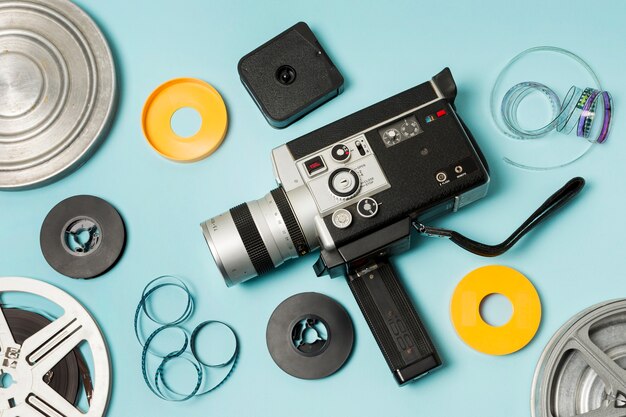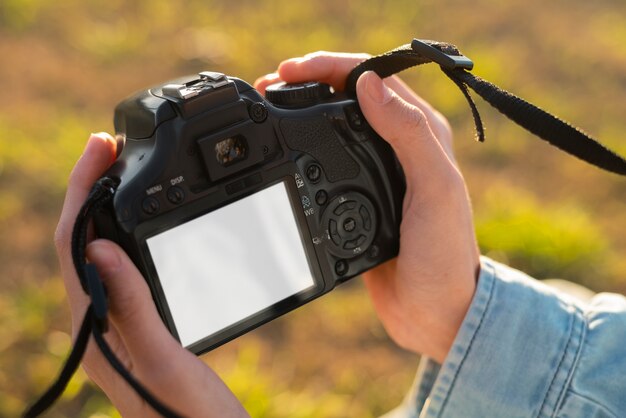How To Use Mini DV Player on Canon CA920 Camera, connect it via the camera’s AV input. Ensure the camera is in VCR mode to view or import Mini DV footage.
Capturing memories or creating video projects often requires transferring footage from various devices. Enter the Canon CA920 camera, an outstanding tool for video enthusiasts who want to incorporate Mini DV tapes into their digital archives. As technology evolves, users sometimes face the challenge of bridging the gap between older formats and new recording devices.
The CA920 caters to this need by allowing the usage of a Mini DV player, thus making it remarkably simple for users to playback or digitize their vintage tapes. This capability not only extends the life of your cherished Mini DV content but also integrates seamlessly with contemporary editing workflows. Whether you’re a seasoned videographer or a hobbyist longing to revisit old footage, the CA920 makes it accessible to relive and repurpose your recorded moments.
Unboxing The Mini DV Player And Canon Ca920
Welcome to the exciting unboxing experience of the Mini DV Player and the sophisticated Canon CA920 camera.
Peek into the box and discover all the tools you’ll need to capture and play high-quality DV recordings.
Items Included In The Box
- Canon CA920 Camera: Your premier tool for capturing memories.
- Mini DV Player: Perfect for convenient playback of your DV tapes.
- Power Adapter: To keep your devices charged and ready.
- A/V Cables: For seamless connection to other media devices.
- Battery Pack: Extra power for extended use.
- User Manuals: Helpful guides to get you started smoothly.
Everything needed is neatly packed in, and ready to use right away.
First Impressions And Build Quality
The Canon CA920 camera impresses with its sleek, professional look.
Its sturdy build promises durability and long-lasting performance.
The Mini DV Player boasts a compact design, perfect for on-the-go playback.
Both devices feature high-quality materials that feel solid to the touch.
Setting Up The Equipment
Setting up your equipment is crucial for capturing great video with your Canon CA920 and a Mini DV player. Follow these steps to connect your devices and manage power effectively. A successful setup leads to a smoother experience and better video playback.
Connecting The Mini DV Player To Canon Ca920
Firstly, gather the necessary cables for your Mini DV player. You will need an AV cable. Ensure your Canon CA920 is off before you start connecting.
- Locate the AV Out port on your Mini DV player.
- Connect one end of the AV cable to the Mini DV player.
- Find the AV In port on your Canon CA920 camera.
- Attach the other end of the AV cable to the camera.
- Switch on both devices to test the connection.
Ensure the connection is secure to prevent interruptions during playback.
Power Requirements And Management
Power is key to using your Mini DV player with the Canon CA920. A consistent power source helps devices work properly.
- Check the Canon CA920 battery is fully charged.
- For the Mini DV player, use its power adapter.
- Plug the adapter into a power socket.
- Turn on the Mini DV player.
Always have spare batteries ready. This ensures your camera stays on during long sessions.
Navigating The Interfaces
Mastering your Canon CA920 camera with a Mini DV Player can be a delight. Let’s dive into the world of buttons and screens. We will explore how to use each interface effectively. This will help you get the best out of your gear.
Understanding The Canon Ca920 Controls
The Canon CA920 has various buttons and dials. Each control has a specific function. Familiarizing yourself with these is key.
- Power Switch: This turns the camera on and off.
- Mode Dial: Switches between camera modes.
- Record Button: Starts or stops recording.
- Zoom Lever: Controls the zoom feature.
- Menu Button: Accesses various settings.
The viewfinder and LCD screen display settings and your shot. Use the navigation buttons to move through menus.
Exploring Mini Dv Player Features
A Mini DV Player is great for viewing tapes directly. Here’s what you can do with it:
| Feature | Description |
|---|---|
| Play | Watch your recorded videos. |
| Fast-Forward/Rewind | Scan through your footage quickly. |
| Pause/Stop | Freeze or end playback. |
| Output Options | Connect to TVs or monitors. |
Remember, the Mini DV Player has its remote. Use it for easy control. Check the input settings on Canon CA920 to ensure proper playback.
Playing And Transferring Videos
If you have a Canon CA920 camera, you own a fantastic tool for recording memories. But what happens after the recording stops? It’s time to playback and transfer your valuable videos for safekeeping or editing!
Inserting Mini DV Tapes
To start, ensure your camera is off. Find the cassette compartment. Press the eject button and wait for the compartment to open. Take a Mini DV tape. Ensure its label faces outward and the tape side faces the lens. Carefully insert the Mini DV tape into the compartment. Gently push the compartment shut. Now, turn on your Canon CA920. Press the ‘play’ button. Your video will appear on the screen. Enjoy the recorded moments!
Transferring Footage To Other Devices
For transferring, turn off your camera first. Connect your Canon CA920 to a computer or other device with a suitable cable, often a FireWire. Turn the camera back on, and set it to ‘playback’ mode. Your device might prompt you with transfer steps. Follow them. If not, open your video capture software. Look for an ‘import’ or ‘capture’ function within the software. Start the transfer with a click. Wait until your videos are safely on your device. Eject the camera once done, and your memories are now ready for sharing or editing!
Maintenance And Care
Proper maintenance keeps your Mini DV Player and Canon CA920 camera in top condition. Dirt, dust, and moisture can damage your equipment. Regular care extends its life and ensures it’s always ready for action. Use these tips for cleaning and storing your devices.
Cleaning Tips For Your Mini DV Player And Canon Ca920
Keep your gear working well with these simple steps:
- Turn off your equipment before cleaning.
- Use a soft, dry cloth for the exterior.
- Remove dust from tight spaces with a blower brush.
- Clean the lens with a microfiber cloth.
- Avoid liquid cleaners that can damage internal parts.
Long-term Storage Advice
Follow these guidelines to store your Mini DV Player and Canon CA920:
- Remove batteries to prevent leakage over time.
- Store in a cool, dry place away from sunlight.
- Use silica gel packets to absorb moisture.
- Encase in a padded bag to avoid scratches.
- Check the device periodically to ensure it remains in good condition.
Troubleshooting Common Issues
Facing trouble with your Mini DV player on the Canon CA920 camera can be frustrating. Your memories are important, and being able to watch them should not be a hassle. Common issues can include playback problems and connection errors but fear not. Simple fixes exist to get you back to reliving those treasured moments. Here’s how you can troubleshoot these issues seamlessly.
Addressing Playback Problems
When your playback isn’t smooth or perhaps not functioning, take the following steps to resolve it:
- Check Tape Condition: Ensure your Mini DV tape is clean and undamaged.
- Clean Heads: Use a head-cleaning cassette to remove dirt from player heads.
- Power Cycle: Turn off the camera, wait a minute, and restart to reset the system.
Compatibility checks are crucial. Confirm that your Mini DV tape format matches your player’s specifications. Some devices may not support all formats.
Resolving Connection Errors
Connection woes can stem from a variety of sources. Here’s a quick guide to fix those:
| Issue | Solution |
|---|---|
| Loose Cables | Secure all cables firmly in their respective ports. |
| Wrong Input Source | Select the correct input source on your viewing device. |
| Faulty Ports | Try different ports to rule out a hardware issue. |
Software updates might be necessary. Ensure your camera’s firmware is up-to-date. If issues persist, restarting both the camera and viewing device can sometimes offer a quick fix.
If you follow these steps, the most common issues with Mini DV players on the Canon CA920 camera should be resolved. Enjoy your viewing experience!
FAQs About How To Use Mini Dv Player On Canon Ca920 Camera
How Do I View Mini Dv Tapes?
To view mini DV tapes, insert them into a mini DV camcorder or player. Connect the device to a television or computer using appropriate cables to watch the footage.
How Do I Convert Mini Dv Tapes To Digital?
To convert mini DV tapes to digital, connect a DV camcorder to your computer using a FireWire cable. Capture the video using video transfer software, then save the file to your hard drive or burn it to a DVD.
How Do You Play MiniDV?
To play a MiniDV tape, insert it into a MiniDV player or compatible camcorder connected to a TV or computer. Press the “Play” button to begin viewing.
How Do I Get Mini Dv Tapes On My Computer?
To transfer mini DV tapes to your computer, connect a digital camcorder to your PC using a FireWire cable. Open a video capture software program, play the tape in your camcorder, and record the footage on your computer.
Can A Canon Ca920 Play Mini Dv Tapes?
Yes, the Canon CA920 camera can play Mini DV tapes when properly connected to a compatible Mini DV player.
How Do I Connect A Mini DV Player To A Ca920?
To connect a Mini DV player to a Canon CA920, use the AV cable to link the player’s output to the camera’s AV input port.
Conclusion
Wrapping up, and mastering your Canon CA920’s Mini DV player enhances your video experiences. Keep the steps concise, practice often, and enjoy the high-quality playback. Embrace the journey to capturing and reliving memories with your beloved camera. Start applying these tips and elevate your videography game today.



